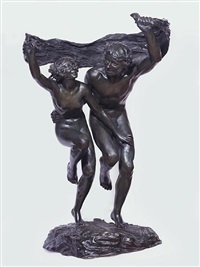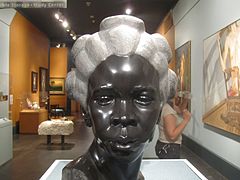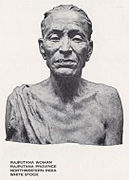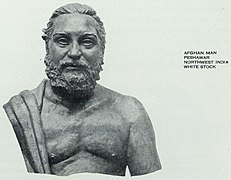Malvina Hoffman
Malvina Cornell Hoffman | |
|---|---|
 Roger Parry,Malvina Hoffman,c. 1920,collection of the Smithsonian Photography Initiative. | |
| Born | June 15, 1885 |
| Died | July 10, 1966(aged 81) New York City, US |
| Education |
|
| Known for | Sculptures of dancers and "Hall of Man" at theField Museum of Natural History |
| Notable work |
|
| Spouse | Samuel Bonarios Grimson (1924–1936) |
Malvina Cornell Hoffman(June 15, 1885 – July 10, 1966)[a]was an Americansculptorand author, well known for her life-size bronze sculptures of people. She also worked in plaster and marble. Hoffman created portrait busts of working-class people and significant individuals. She was particularly known for her sculptures of dancers, such asAnna Pavlova.[1][6]Her sculpture series of culturally diverse people, entitledHall of the Races of Mankind,was a popular permanent exhibition at theField Museum of Natural Historyin Chicago.[7]It was featured at theCentury of ProgressInternational Exposition at the Chicago World's Fair of 1933.[8]
She was commissioned to execute commemorative monuments and was awarded many prizes and honors, including a membership to theNational Sculpture Society.In 1925, she was elected into theNational Academy of Designas an Associate member and became a full Academician in 1931.[9]Many of her portraits of individuals are among the collection of theNew York Historical Society.She maintained asalon,a social gathering of artistic and personal acquaintances, at herSniffen Courtstudio for many years.[9]
She was highly skilled in foundry techniques, often casting her own works.[8]Hoffman published a definitive work on historical and technical aspects of bronze casting,Sculpture Inside and Out,in 1939.[8][9]
Early life and education
[edit]Malvina Hoffman was born in New York City, the fourth of six children of the concert pianist and composer,Richard Hoffman,and Fidelia Marshall (Lamson) Hoffman.[1][3]She was named after a maternal aunt, Malvina Helen (Lamson) Cornell, who would later survive the sinking of theRMSTitanic.Her mother, also a pianist, presided over her education at home until she was 10 years of age.[1][2]The Hoffman's regularly entertained artists and musicians in their home.[1]As a young girl, she metSwami Vivekanandawhen he lived and taught in New York City, and several of her later sculptures, like that ofSri Ramakrishna,are located at theRamakrishna-Vivekananda Centerof New York.[10][b]
Hoffman attendedVeltin School for Girls,[9]Chapin,andBrearleyprivate schools.[1]While at Brearley, she took evening classes at the Woman's School for Applied Design and theArt Students League of New York.[1]
She studied painting withJohn White Alexanderin 1906,[1][9]and also with Harper Pennington.[1]Hoffman developed her skill as an artist during her studies withGeorge Grey Barnard,Herbert Adams,andGutzon Borglum.[1][9]She worked as an assistant to sculptorAlexander Phimister Proctorat hisMacDougal Streetstudio inGreenwich Villagein 1907.[12]In 1908, Hoffman traveled to Paris withKatharine RhoadesandMarion H. Beckettand studied art there.[13]
In 1909 she made a bust of her father, her first finished sculpture, two weeks prior to his death. It was exhibited at the National Academy the following year.[2][9]Also in 1910, she won an honorable mention for a sculpture of her future husband, Samuel Grimson, at theParis Salon.[3]Hoffman gravitated towards sculpture due to the artistic freedom she felt when creating a three-dimensional work of art.[2]
After her father's death in 1910, Hoffman moved to Europe with her mother.[14]They first visited London, where they attended the ballet ofAlexander Glazunov'sAutumn Bacchanale.Hoffman was inspired by the combination of motion and control exhibited byMikhail MordkinandAnna Pavlova.[1]Mother and daughter visited Italy before moving to Paris.[14]She worked as a studio assistant forJanet Scudder.During the nights she studied atAcadémie Colarossi.She studied with Emanuele Rosales[1]and after five unsuccessful attempts, she eventually was accepted as a student byAuguste Rodin.[2][15]She caught his attention when she quoted a poem that he attempted to remember byAlfred de Musset.[2]During their lessons, he advised her, "Do not be afraid of realism".[16]She made a trip toManhattanin 1912 to dissect bodies at theCollege of Physicians and SurgeonsatColumbia University.[1]From Rosales and Rodin, she learned about bronze casting, chasing, and finishing at foundries.[3]The Hoffman women lived in Paris until the outbreak ofWorld War Iin 1914.[1]
Career
[edit]Dancers
[edit]Hoffman became famous internationally for her sculptures of ballet dancers, such asVaslav Nijinskyand Anna Pavlova, who often posed for her.[8][9]In 1911, she madeRussian Dancers,which was exhibited that year at the National Academy and the following year at theParis Salon.She made a plaster bust, the last work she made of Pavlova, in 1923.[9]Hoffman also created friezes and other works that captured the movements of dancers. In 1912, she madeBacchanale Russe.In 1917, a version of it won the National Academy's Julia A. Shaw Memorial Prize and the next year a large casting of the sculpture was on display in Paris at theLuxembourg Gardens.[9]She has been called "America's Rodin".[2]
World War I
[edit]Hoffman helped to organize, and was the American representative, for the French war charity,Appui aux Artistesthat assisted needy artists. She also organized the American-Yugoslav relief fund for children.[1]While working for the Red Cross during World War I, Hoffman traveled toSerbia.[17]She made a larger-than-life-sized work of Croatian sculptorIvan Meštrović,with whom she studied.[8]
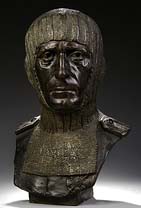
Her sister, Helen, was on the board of theRed Cross,which sent clothing and medical supplies for the Serbian cause. Through her sister, she met Serbian ColonelMilan Pribićevićin 1916, who inspired her when he came to the United States and delivered rousing speeches in which he asked Serbian immigrants to fight to save their homeland. Hoffman, who may have had a romantic relationship with the colonel, had an interest in "powerful, charismatic" people. She once said, "Hero worship formed a major part of my emotional life". He modeled for her sculpture of him entitledA Modern Crusader(1918).[19]His nephew said that it capture that "he was gaunt and weary. His eyes were deep sunk in their sockets... Only his firm mouth and his powerful chin showed no trace of the inhuman punishment which his body and soul had received during half a decade of life in the trenches."[20]There are casts at theMetropolitan Museum of Art,Smithsonian American Art Museum,andArt Institute of Chicago.[17]

She also created the well known posterSerbia needs your help,based on the Miloje P. Igrutinović's photo of dead Serbian soldiers who had died of hunger and exhaustion on the Greek island ofVido.She made the soldier "live" on the poster and later, as a sort of an artistic installation, posted the soldier's head on the bronze statue of the SaintFrancis of Assisiin front of theMayo ClinicinRochester, Minnesota.[21][22]She published her impressions about her visit in the chapter "Hunger in the Balkans" of her bookHeads and Tales.[23]
The posterSerbia needs your helplater circulated around the United States, including the library of a local politician in Phoenix, Arizona, or in the Navajo reservation. That was where the priest Janko Trbović found it. One reprint of the poster, after an intricate and extended search, was donated by the basketball playerVlade Divac.[23]
In 2018, an exhibitionWho is Malvina Hoffmandedicated to her work was opened inNovi Sad,Serbia. It was part of the wider project "Serbia, war and posters" by the state government. The Hoffman exhibition, organized in cooperation with the US embassy inBelgrade,later toured the entire country.[21][22]Among other exhibits, Hoffman's drawings which she made when she visited Serbia in 1919 were also displayed.[23]
Interwar period
[edit]
In 1919, she created a pedimental sculpture forBush Housein London. The same year, she was in Paris cataloging Rodin's works for theMusée Rodin.[9]In 1929, her first major exhibit was held at theGrand Central Art Galleries[9]with 105 works of art in various mediums.[8]
During the war, she met the American Red Cross workerJohn W. Frothinghamand his Serbian wifeJelena Lozanić.As member of the American Red Cross, she and Lozanić continued to organize the relief for Serbia (now amalgamated intoYugoslavia) during theInterbellum,regularly giving lectures on orphaned Serbian children. She welcomed Croatian sculptorIvan Meštrović,lending him her studio to work. In 1919, at the request ofHerbert Hoover,director ofAmerican Relief Administration,Hoffman travelled to Serbia and Yugoslavia to visit US humanitarian missions throughout the state. That same year she visited the site of the 1389Battle of Kosovo,as the second recorded American to do so, after John W. Frotingham (some even claim the second foreign visitor in general).[24]
After the war, she made the sculptureThe Sacrifice,which was dedicated in 1923 at theCathedral of St. John the Divinein New York. In it, the head of a 13th-century crusader lay on the lap of a draped woman. It is a memorial to the late Ambassador of France,Robert Bacon,and alumni of Harvard University who lost their lives during the war.[25]After theMemorial Churchat Harvard University was completed in 1932, it was installed there.[9][26]
Hall of Man
[edit]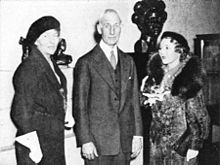
In 1929, Hoffman received a telegram from Stanley Field, "Have proposition to make, do you care to consider it? Racial types to be modeled while traveling round the world."[15]The original proposal was to commission four or five artists to create painted plaster figures, as was common at the time, but Hoffman countered with a proposal to do the entire series by herself.[15]Her counter-proposal was accepted, and she was commissioned by theField Museum of Natural HistoryinChicago, Illinoisto create anthropologically accurate sculptures of peoples of diverse nationalities and races.[15]Next, she determined to do the entire series in bronze, submitted two initial sculptures, and obtained approval to proceed.[15]
Her initial work on the series was done in her Manhattan studio, but then she moved to her studio in Paris, where she could refer to models from theParis Colonial Expositionof 1931.[15]She then traveled around the world — including distant places like Africa, India, and Bali — in 1931 to 1932, creating busts and figures of people[9]and taking more than 2,000 photographs.[27]
To understand the submerged passion that burns in the human eye, to read the hieroglyphs of suffering etched in the lines of a human face... to watch the gesture of a hand or listen for the false notes and the truth in a human voice, these are the mysteries that I found I must delve into and try to unravel when I made a portrait.
—Malvina Hoffman, explaining that her sculptures were more than an anthropological study.[8]
| External images | |
|---|---|
She completed more than 105 sculptures, predominantly in bronze, but also in marble and stone.[8]They included busts and full-length figures of individuals,[8]which were installed at the museum'sHall of Manin 1933. She documented her travels for the commission in the book,Heads and Tales.[9]It was a popular exhibit at the museum, but some critics considered it a purely anthropological study.[8]
During the 1960s, questions began to circulate about the exhibit. According toAmerican Historical Review,"the sculptures in the 'Races of Mankind' had perpetuated an older typological approach by presenting 'race' in the form of literally static bronze figures depicting idealized racial 'types'".[28]TheHall of Manwas deinstalled in 1969,[29]but some of the sculptures remained on display.[15]
In 2016, fifty recently conserved sculptures from theMankindcollection were re-installed at the museum in an exhibition calledLooking at Ourselves: Rethinking the Sculptures of Malvina Hoffman.[30][31][32]
World War II
[edit]
As she had during World War I, Hoffman served theRed Cross[17]and she raised money for the Red Cross and national defense during the war.[34]She again supported Serbia, which was again occupied by Germany. Jointly with the mayor of New York City,Fiorello La Guardia,she participated in the fund raising events of organized by Jelena Lozanić, and in sending of the relief to the occupied territory.[24]
In 1948, Hoffman created relief sculptures for the walls of theAmerican World War II Memorialfor theEpinal American Cemetery and MemorialinVosges,France.[33]It is on the site of theBattle of the Bulge(1944). There are 5,255 American soldiers buried in the cemetery.[26]
Other
[edit]
She depicted the evolution of medicine in a 13-panel bas relief for Boston'sJoslin Diabetes Center.Hoffman made portrait sculptures, including those ofJohn Muir,Wendell Willkie,[8]Ignacy Jan Paderewski,Henry Clay Frick,andIvan Meštrović.Her works were exhibited often at the National Academy.[9]In 1965, she publishedYesterday is Tomorrow.[9]
Among her awards[34]are the gold medal she won in 1924 from the National Academy, the gold medal of honor she won in 1962 forMongolian Archerfrom the Allied of Artists of America, and the gold medal of honor that she won in 1964 from theNational Sculpture Society.[35]She was awarded five honorary doctorates.[34][36]Her awards for public service include theFrench Legion of Honourand the Royal Order of St. Sava III of Yugoslavia.[34]
Her work is kept in the permanent collections of many museums worldwide, including theMetropolitan Museum of Art,[37]theDetroit Institute of Arts,[38]theSanta Barbara Museum of Art,[39]theVero Beach Museum of Art,[40]theHarvard Art Museums,[41]theUniversity of Michigan Museum of Art,[42]theDallas Museum of Art,[43]theSmithsonian American Art Museum,[44]theNasher Museum of Art,[45]and theGilcrease Museum.[46]
Personal life
[edit]
She was married to an Englishman,Samuel Bonarius Grimson,on June 4, 1924.[3][47]Grimson had been injured bymustard gasandphosgeneduring World War I, and his career as a concert violist was ended when his hands were crushed during an accident with a truck during the war. After the war, he collected antique paintings and instruments. He also invented a tube for a color television.[48]Grimson traveled with her during her search for authenticindigenousmodels for the anthropological series.[8]Hoffman and Grimson divorced in 1936; some speculated that it was due to an affair that she had with the ballerina Anna Pavlova.[47]Grimson later married Bettina Warburg, the daughter of Nina Loeb andPaul Warburg,[48][49]in 1942. She was 16 years his junior. Grimson died in 1955.[47][48]
Hoffman befriended painterRomaine Brooks,writerGertrude Stein,and ballet dancerAnna Pavlova.She held costume parties and balls in her studio, which were reported in the city's society pages.[8]She often spent the summers in aHartsdalecottage provided to her by Paul Warburg.[50]
On July 10, 1966, Malvina Cornell Hoffman died of a heart attack in her studio in Manhattan,[8]which had been purchased by the philanthropistMary Williamson Averelland provided to Hoffman for a low-priced rent.[50]
Gallery
[edit]-
Mort Exquise(1913)
-
Boy and Panther Cub(1915)
-
Boy and Panther Cub,detail (1915)
-
Anglo-American Friendship,Bush House(1919)
-
L'Offrande(1920)
-
Pavlova(1926-1929)
-
Martinique Woman(1927)
-
Coal Miners Returning From Work(1939)
-
Berber Man(1948)
-
Rajputana Woman(1948)
-
Afghan Man(1948)
-
Kashmiri in Meditation
Notes
[edit]- ^Her date of birth is June 15, 1885 according to secondary sources[2][3]and the Social Security record of her death.[4]Her year of birth is also given as 1887.[5]
- ^Others sculptures at the Ramakrishna-Vivekananda Center areSarada Devi,Sri Ramakrishna,Swami VivekanandaandSwami Nikhilanandabust for Ramakrishna Vivekananda Center of New York[11]
References
[edit]- ^abcdefghijklmnoJules Heller; Nancy G. Heller (December 19, 2013).North American Women Artists of the Twentieth Century: A Biographical Dictionary.Taylor & Francis. p. 257.ISBN978-1-135-63889-4.
- ^abcdefgCarol Kort; Liz Sonneborn (May 14, 2014).A to Z of American Women in the Visual Arts.Infobase Publishing. p. 95.ISBN978-1-4381-0791-2.
- ^abcdeBarbara Sicherman; Carol Hurd Green (1980).Notable American Women: The Modern Period: a Biographical Dictionary.Harvard University Press. p.343.ISBN978-0-674-62733-8.
- ^Malvina Hoffman, Issued in New York, 1952-1954,Social Security Death Index, Master File. Social Security Administration, July 1966
- ^Marianne Kinkel (2011).Races of Mankind: The Sculptures of Malvina Hoffman.University of Illinois Press. p. 9.ISBN978-0-252-03624-8.
- ^Essays on Women's Artistic and Cultural Contributions 1919–1939.2009. p. 164.
- ^Field Museum (January 1979).The Legacy of Malvina Hoffman.Vol. 50. Field Museum of Natural History Bulletin.RetrievedMay 15,2011.
- ^abcdefghijklmnCarol Kort; Liz Sonneborn (May 14, 2014).A to Z of American Women in the Visual Arts.Infobase Publishing. p. 96.ISBN978-1-4381-0791-2.
- ^abcdefghijklmnopqDavid Bernard Dearinger (2004).Paintings and Sculpture in the Collection of the National Academy of Design: 1826-1925.Hudson Hills. p. 276.ISBN978-1-55595-029-3.
- ^"Malvina Hoffman Sculptures at the Ramakrishna-Vivekananda Center of NY".ramakrishna.org.RetrievedMarch 7,2016.
- ^"Malvina Hoffman Sculpture of Sri Sarada Devi".ramakrishna.org.RetrievedMarch 7,2016.
- ^Sarah E. Boehme (Spring 2004)."Alexander Phimister Proctor and Gertrude Vanderbilt Whitney: Sculptor in Buckskin and American Princess".Points West magazine.RetrievedJanuary 29,2017– via Buffalo Bill Center of the West.
- ^Wardle, Marian (2005).American women modernists.[Provo (Utah)]: Brigham Young university Museum of Art. p. 223.ISBN978-0813536842.RetrievedSeptember 5,2016.
- ^abBailey, Brooke (1994).The Remarkable Lives of 100 Women Artists.Bob Adams Inc. pp.78–79.ISBN1-55850-360-9.
- ^abcdefg"Malvina Hoffman".Field Museum of Natural History.November 8, 2011.RetrievedJanuary 31,2017.
- ^"A Little Girl Who Remembered Vivekananda"(PDF).Archived fromthe original(PDF)on July 11, 2015.
- ^abcLauretta Dimmick; Donna J. Hassler (January 1, 1999).American Sculpture in the Metropolitan Museum of Art: A catalogue of works by artists born between 1865 and 1885.Metropolitan Museum of Art. p. 738.ISBN978-0-87099-923-9.
- ^"Modern Crusader | Smithsonian American Art Museum".americanart.si.edu.RetrievedMay 31,2020.
- ^Metropolitan Museum of Art (New York, N.Y.) (January 1, 2003).Perspectives on American Sculpture Before 1925.Metropolitan Museum of Art. pp. 130–131.ISBN978-1-58839-105-6.
- ^"Modern Crusader".Smithsonian American Art Museum.RetrievedJanuary 30,2017.[permanent dead link]
- ^abS.K. (April 22, 2018). "Ko je Malvina Hofman" [Who is Malvina Hoffman].Politika(in Serbian).
- ^abMiona Kovačević (May 21, 2017).""Serbia needs your help"Kako je jedna Amerikanka oživela mrtvog srpskog vojnika"[ "Serbia needs your help" How one American woman made a dead Serbian soldier alive] (in Serbian).Blic.
- ^abcBrane Kartalović (September 21, 2018)."Malvina Hofman –" Srbiji je potrebna tvoja pomoć ""[Malvina Hoffman – "Serbia needs your help" ].Politika(in Serbian). p. 12.
- ^abTomislav Simonović (March 31, 2020).Како смо заборавили највећег српског добротвора из САД - Косовски дан Малвине Хофман, део 20 (изводи из књиге Џон В. Фротингхам, заборављени српски добротвор[How we forgot the greatest Serbian benefactor from USA - Kosovo Day of Malvina Hoffman (excerpts from the book John W. Frotingham, forgotten Serbian benefactor].Politika(in Serbian). p. 23.
- ^American Scenic and Historic Preservation Society (1922).Annual Report of the American Scenic and Historic Preservation Society to the Legislature of the State of New York.pp.41–42.
- ^abPaula E. Calvin; Deborah A. Deacon (September 8, 2011).American Women Artists in Wartime, 1776-2010.McFarland. p. 84.ISBN978-0-7864-8675-5.
- ^"Photo Archives - Malvina Hoffman Collection".Field Museum of Natural History.February 18, 2011.RetrievedJanuary 31,2017.
- ^Brattain, Michelle,"Race, Racism, and Antiracism: UNESCO and the Politics of Presenting Science to the Postwar Public".The American Historical Review 112.5 (2007): 40 pars. March 11, 2010.
- ^Thomas W. Gaehtgens(March 5, 2013).Getty Research Journal.Getty Publications. pp. 123, 128.ISBN978-1-60606-136-7.
- ^"Looking at Ourselves: Rethinking the Sculptures of Malvina Hoffman - Field Museum".Field Museum.RetrievedApril 23,2023.
- ^Rothstein, Edward (March 22, 2016)."'Looking at Ourselves: Rethinking the Sculptures of Malvina Hoffman' Review ".Wall Street Journal.Dow Jones & Company, Inc.RetrievedApril 23,2023.
- ^Edward Rothstein (March 23, 2016). "A Mold in Which to Cast a New Orthodoxy".Wall Street Journal.p. D5.
- ^abLemay, Kate Clark (February 14, 2019)."How the U.S. Designed Overseas Cemeteries to Win the Cold War".What It Means to Be American.
- ^abcdJules Heller; Nancy G. Heller (December 19, 2013).North American Women Artists of the Twentieth Century: A Biographical Dictionary.Taylor & Francis. p. 258.ISBN978-1-135-63889-4.
- ^"2 Receive Sculptor Society Medals".The New York Times.February 12, 1964.RetrievedApril 23,2023.
- ^Carol Kort; Liz Sonneborn (May 14, 2014).A to Z of American Women in the Visual Arts.Infobase Publishing. pp. 96–97.ISBN978-1-4381-0791-2.
- ^"Malvina Cornell Hoffman | Daboa".metmuseum.org.RetrievedJanuary 15,2021.
- ^"Russian Dancers".dia.org.RetrievedJanuary 15,2021.
- ^"Malvina HOFFMAN - Artists - eMuseum".collections.sbma.net.RetrievedJanuary 15,2021.
- ^"Malvina Hoffman | Vero Beach Museum of Art".vbmuseum.org.January 21, 2018.RetrievedJanuary 15,2021.
- ^Harvard."From the Harvard Art Museums' collections La Javanese".harvardartmuseums.org.RetrievedJanuary 15,2021.
- ^"Exchange: Small Study for the Column of Life".exchange.umma.umich.edu.RetrievedJanuary 15,2021.
- ^"Untitled - DMA Collection Online".dma.org.RetrievedJanuary 15,2021.
- ^"Malvina Hoffman | Smithsonian American Art Museum".americanart.si.edu.RetrievedJanuary 15,2021.
- ^"The Column of Life".Nasher Museum of Art at Duke University.RetrievedJanuary 15,2021.
- ^"Sign Talk / Malvina Hoffman - Gilcrease Museum".collections.gilcrease.org.RetrievedJanuary 15,2021.
- ^abcKatharine Weber (June 2012).The Memory of All That: George Gershwin, Kay Swift, and My Family's Legacy of Infidelities.Crown/Archetype. pp. 166–167.ISBN978-0-307-39589-4.
- ^abcRon Chernow (November 15, 2016).The Warburgs: The Twentieth-Century Odyssey of a Remarkable Jewish Family.Knopf Doubleday Publishing Group. p. 605.ISBN978-0-525-43183-1.
- ^"Bettina Warburg Grimson; Psychiatrist, 90".New York Times.November 28, 1990.
- ^abMarianne Kinkel (2011).Races of Mankind: The Sculptures of Malvina Hoffman.University of Illinois Press. p. 212.ISBN978-0-252-03624-8.
Further reading
[edit]- Connor, Janis, and Joel Rosenkranz,Rediscoveries in American Sculpture – Studio Works, 1893–1939,University of Texas Press, Austin 1989
- Field, Henry,The Races of Mankind, Sculptures by Malvina Hoffman,Anthropology Leaflet 30, Field Museum of Natural History, Chicago 1937
- Hoffman, Malvina,Heads and Tales.Charles Scribner's Sons, NY, NY 1936
- Hoffman, Malvina,Sculpture Inside and Out,Bonanza Books, NY, NY 1939
- Hoffman, Malvina,Yesterday Is Tomorrow,Crown Publishers, Inc. NY, NY 1965
- Kvaran, Einar Einarsson,Hunting Hoffman in the Field Museum,unpublished manuscript
- Nishiura, Elizabeth,American Battle Monuments – A Guide to Military Cemeteries and Monuments Maintained By the American Battle Monuments Commission,Omnigraphics, Inc, Detroit, Michigan 1989
- Papanikolas, Theresa and DeSoto Brown,Art Deco Hawai'i,Honolulu, Honolulu Museum of Art, 2014,ISBN978-0-937426-89-0,p. 79
- Proske, Beatrice Gilman,Brookgreen Gardens Sculpture,Brookgreen Gardens, South Carolina, 1968
- Redman, Samuel J,Bone Rooms: From Scientific Racism to Human Prehistory in Museums.Cambridge: Harvard University Press. 2016.
External links
[edit]![]() Media related toMalvina Hoffmanat Wikimedia Commons
Media related toMalvina Hoffmanat Wikimedia Commons
- Malvina Hoffman papers, 1897–1984.Getty Research Institute,Los Angeles. A nearly complete archive of letters, manuscripts, photographs, diaries, drawings, and films documents Malvina Hoffman's life and her career as a sculptor and writer.
- Photo of Malvina HoffmanbyClara Sipprell,at theAmon Carter Museum of American Art
- 20th-century American sculptors
- 1885 births
- 1966 deaths
- 20th-century American women writers
- Artists from New York City
- American modern sculptors
- National Sculpture Society members
- National Academy of Design members
- Brearley School alumni
- Chapin School (Manhattan) alumni
- Sculptors from New York (state)
- Writers from Manhattan
- American salon-holders
- Members of the American Academy of Arts and Letters
- 20th-century American women sculptors



